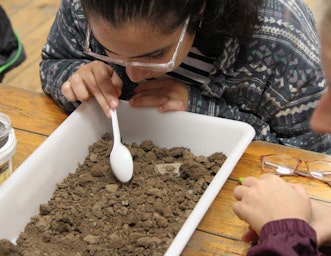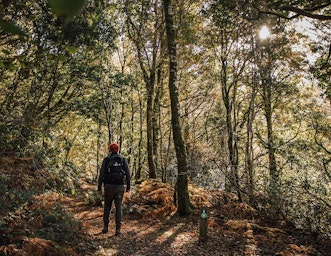
Tenant wanted: must eat grey squirrels
February 1, 2019Home » Tenant wanted: must eat grey squirrels
Rumours of strange, unfamiliar creatures in the woods around CAT have caused much excitement over the past few weeks.
Woodland Officer Alex Chadwick is hoping a pine marten has come to stay.
Pine martens are incredibly charismatic but elusive creatures. They are thought to have inhabited Britain since the end of the last ice age, but they have been so rare in Wales in recent times that a discovery of pine marten road kill in 2012 was their first confirmed ‘sighting’ since 1971.
This rarity was caused, sadly but unsurprisingly, by humans: habitat loss and fragmentation of woodlands, historical hunting for their fine fur, and illegal poisoning and shooting (they are protected by the Wildlife and Countryside Act), pushed them almost to extinction in England, and confined them to small isolated areas of Snowdonia in Wales.
A relatively healthy population has endured in Scotland however – and therein lies hope.
The Pine Marten Recovery Project
The Vincent Wildlife Trust is a small British charity focusing on mammal conservation. For the past few years they have been running the Pine Marten Recovery Project to help the pine marten regain a viable population size in Wales.
They also run a sister programme called ‘Back from the Brink’, based in England. After extensive site surveys, local engagement, and acquiring all the relevant licenses, the first pine martens were translocated from Scotland to rural mid Wales in 2015. Two more translocations were completed in the autumn of 2016 and 2017, with a total of 51 pine martens successfully moved to a new home here in Wales. They were all initially radio collared and extensively monitored, but the collars have since been removed now that the pine martens have established themselves.

A thorny issue
Population reinforcements like this one (and wildlife reintroductions in general) are almost always controversial, with vested interests on both sides getting involved in the debate. In many ways this is only right, as interfering in the ecology of ecosystems is not something that should be taken lightly, even if we are simply trying to restore it.
Add to this the potential impacts on human activities and the issue can quickly become complicated. The feasibility study for the mid Wales project conducted a public opinion survey, which was released online by the Vincent Wildlife Trust, and found some interesting things:
- A very high proportion (87.3%) of those consulted would support a restocking of pine marten in Wales.
- Those that worked in leisure and tourism or wildlife conservation were most likely to be supportive, citing their native status, a perceived positive effect on biodiversity, and its contribution to a balanced environment.
- Respondents who worked in farming, game-keeping and estate management were most likely to oppose a re-stocking, with the main reasons given as predation of wildlife, prioritising the native population, and lack of suitable habitat/knowledge of the current population status.
Our view
We in the woodlands team at CAT would be delighted to welcome pine martens into our woodlands, for a number of reasons, both principled and practical.

In recent years there has been a great deal of interest in the effects that predators have on ecosystems, through a series of knock on effects known as a trophic cascade – the reintroduction of wolves to Yellowstone National park is one well known example, and is well worth some reading if you aren’t familiar with it.
Some research has been published recently (based on reintroductions in Ireland) that suggests pine martens might have a similar effect to that which the wolves had on deer in Yellowstone, on one very problematic pest species for our woodlands here – grey squirrels. Grey squirrels are a highly invasive species in the UK, as not only have they pushed out the native red squirrels, but they also frequently ring bark trees – gnawing at the bark right the way around the trunk to get to the sugary liquids inside. This necessarily kills the tree above the ring bark.
Pine martens, as natural predators of small mammals, would seem to be the perfect predator of grey squirrels. In the study in Ireland, suppressing the population of grey squirrels through predation in this way actually gave the red squirrels a chance to regain lost territory.

Of course, pine martens would predate red squirrels as well, however, since the greys spend more time on the ground (rather than up in trees) than reds, they are more likely to encounter pine martens. Greys are also larger, meaning they are less able than the reds to escape from a predator by fleeing across small branches. As a result, both grey and red squirrels facing pine martens as a predator actually gives the reds a competitive edge. It would also help protect our trees – seemingly a win-win!
A moral responsibility
There is another reason that is often overlooked when considering the practical implications of reintroductions. Since it was human activity (including active persecution) that pushed pine martens to the brink of extinction, we have a moral responsibility to both conserve them now and to help them recover in the future. It is an important aspect of sustainable land management to recognise that all ecosystems are a complex, interdependent web of species interacting with each other in a potentially delicate equilibrium. So even if we can’t see a practical reason or a benefit to ourselves from conserving a species, it still occupies a niche in its ecosystem, which could have unforeseeable consequences if removed. At the end of the day pine martens are, like so many other species, a part of our natural heritage, and I for one would be very happy to see one more wonderful species brought back from the brink.
About the author
As part of our woodlands team, Alex helps manage the CAT site to enhance biodiversity, creating a haven for a wide variety of species. He also gives tours and workshops to increase knowledge and understanding of nature
- Woodland
- Nature and Wildlife
Related Topics
Related news


CAT joins Protecting our Planet Day for schools
28th November 2023
Why we teach… ecological assessment
22nd April 2023

